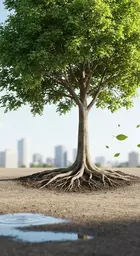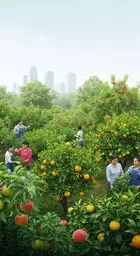Protect Urban Trees from Heat

Posted on: 2025-04-23
By: Keira Vallejo
Understanding Summer Tree Care: Importance of Protecting Urban Trees from Heat Stress
As the summer sun beats down, our urban trees face a real challenge—heat stress. It’s crucial to recognize the signs early, as this will help us best support these green giants during sweltering months. At Urban Canopy Blog, we believe that understanding how to care for our trees in extreme heat can make all the difference in keeping our city landscapes vibrant and healthy!
Our mission is to empower urban communities with knowledge about tree care, especially during the hot summer season. By learning to identify the subtle signs of heat stress, we can act quickly to ensure our trees thrive. So, let’s dive into the world of summer tree care and see how we can protect our urban forests from the heat!
Recognizing the Threat: Heat Stress Indicators in Trees
First things first, recognizing the symptoms of heat stress is essential for effective tree care. Trees can’t tell us when they’re struggling, but we can look for telltale signs. Here’s what to watch for:
- Wilting: Leaves may droop or curl, indicating that the tree is losing moisture.
- Yellowing Leaves: A shift in color can be a sign that your tree is stressed and needs attention.
- Leaf Drop: Trees shedding leaves prematurely can also signal heat-related issues.
By keeping an eye on these indicators, we can take proactive steps to address heat stress before it becomes a serious threat. Remember, the sooner we act, the better our trees can cope with the summer heat. For more in-depth information on selecting the right trees for your urban space, check out our guide on selecting trees for urban spaces.
Identifying Symptoms: Wilting, Drooping, and Yellowing Leaves
Wilting and drooping leaves are often the first signs we notice. When temperatures soar, a tree’s ability to retain moisture diminishes, leading to dehydration. If you spot leaves that are droopy or yellowing, it's a call to action! Don’t wait for the tree to show more severe symptoms—take steps to hydrate it.
It’s important to check the overall health of the tree as well. If the tree is showing multiple stress indicators, it may need immediate attention. Your urban trees work hard to enhance our environment, so let’s give them the care they deserve!
Understanding Water Loss and Its Effects on Tree Health
Water loss during high temperatures can dramatically affect a tree's health. Just like we need water to stay hydrated, trees depend on it to support their biological functions. When trees lose too much water, their metabolism slows down, which can lead to stunted growth and increased vulnerability to pests and diseases.
To combat this, we should consider how irrigation practices can benefit our trees. Regular deep watering sessions can help trees develop strong root systems, making them more resilient to heat stress and drought conditions. It’s a win-win situation for both your trees and the community! For more information on effective watering techniques, see our article on essential tree watering methods.
Exploring the Consequences of Rising Temperatures on Urban Trees
As temperatures rise, the consequences for urban trees can be significant. For trees in city environments, heat stress doesn't just mean wilting leaves—it's a complex issue that impacts their overall health and longevity. Let’s explore some of the key effects of rising temperatures on our beloved urban trees.
- Increased Respiration: Trees may struggle to photosynthesize, leading to reduced growth.
- Heat Lesions: Extreme temperatures can cause bark damage, leaving trees prone to infections.
- Soil Temperature Rise: Warmer soil can affect nutrient availability, making it harder for trees to thrive.
Understanding these consequences enables us to take appropriate actions to mitigate heat stress. By staying informed, we can ensure our trees remain healthy and resilient through the hottest months! Learn more about the impact of urban trees on cooling city heat in our article: Urban Trees Cool City Heat.
Impact of Increased Respiration and Water Loss in Trees
When temperatures rise, trees increase their respiration rates. This heightened activity means they consume more energy, leading to reduced growth. Not only can this affect their development, but it also makes them more susceptible to diseases!
By actively managing water loss through proper care techniques, we can greatly improve our trees' resilience to heat. Regular monitoring and timely interventions are key to ensuring that our urban green spaces flourish despite the heat.
Heat Lesions and Long-term Damage to Tree Health
Heat lesions are another concern during hot summers. These can manifest as cracks or scars on the bark, resulting from rapid temperature changes. Over time, heat lesions can weaken the tree, opening it up to pests and diseases.
Protecting trees from extreme heat is crucial to their long-term health. Regular inspections can help you catch these issues early. Remember, a healthy tree contributes to a healthier urban environment!
The Role of Soil Temperature in Tree Resilience
The soil temperature plays a vital role in the overall resilience of urban trees. High soil temperatures can affect root function and nutrient uptake, causing additional stress on the tree. By maintaining a cooler soil environment through mulching or strategic watering, we can promote healthier roots and overall tree vitality.
Let’s make an effort to keep our trees' root systems happy and cool this summer. After all, healthy roots lead to flourishing canopies, enhancing the beauty and functionality of our urban spaces!
Effective Preventative Care Strategies for Urban Tree Health
Now that we understand the effects of heat stress on our trees, let’s focus on preventative care strategies. With the right approach, we can help our urban trees stay strong and healthy through the summer heat. Here are some effective strategies to consider:
- Watering Tips: Deep watering once a week can help ensure your trees receive enough moisture.
- Mulching: Apply a layer of organic mulch around the base to retain moisture and regulate soil temperature.
- Early Recognition: Regularly inspect for symptoms of heat stress, such as wilting leaves or excessive leaf drop.
- Pruning Techniques: Proper pruning can improve airflow and light penetration, helping trees cope with heat.
Implementing these strategies can make a significant difference in the health of our urban trees. Let's work together to ensure they have the support they need to thrive, year after year! For more seasonal tips, check out our complete guide: Summer Tree Care Tips for Cities.
Watering Tips: Timing and Techniques for Optimal Hydration
Timing is everything when it comes to watering trees. The best time to water is in the early morning or late evening, when temperatures are cooler. This prevents excessive evaporation and ensures that the roots can absorb the moisture effectively.
When watering, aim for a deep soak. Focus on the area around the root zone, making sure water penetrates deeply into the soil. This will encourage roots to grow downwards, improving the tree’s stability and resilience against heat stress!
The Benefits of Mulching: Maintaining Moisture and Soil Health
Mulching is one of the best things you can do for your urban trees! By applying a thick layer of organic mulch, you can:
- Retain soil moisture and reduce the frequency of watering.
- Suppress weed growth, allowing trees to access nutrients without competition.
- Enhance soil structure, promoting healthier root systems.
It’s a simple yet effective technique that can have a profound impact on tree health. Plus, it helps keep our urban landscapes looking tidy and vibrant!
Early Recognition of Heat Stress: Signs to Watch For
Being proactive is key in tree care. Regularly check for early signs of heat stress, such as wilting and yellowing leaves. The sooner you catch these symptoms, the sooner you can intervene and provide the necessary care.
Don’t hesitate to reach out to your local tree care professionals or community resources for support. Together, we can ensure that our trees remain resilient and healthy throughout the summer!
Pruning Techniques for Enhancing Tree Canopy and Health
Pruning is an essential part of summer tree care. Correctly pruned trees can better withstand heat stress and improve airflow throughout the canopy. When pruning, focus on removing dead or crossing branches, which allows for better light penetration and encourages healthy growth.
Consider scheduling a pruning session during the cooler parts of the day to minimize stress on the tree. Your trees will thank you with lush, vibrant foliage!
Local Insights: Adapting Tree Care to Regional Climate Conditions
Every urban area has its unique climate challenges, and adapting tree care practices is essential for success. Understanding local climate conditions can help us select the right tree species and optimize our care techniques. Let’s explore how to make tree care work for our local environment!
- Selecting Suitable Species: Choose tree varieties that are well-adapted to your region’s climate.
- Incorporating Climate Data: Use local weather patterns to inform your watering and care schedules.
- Drought Resistance: Prioritize species that can withstand dry spells and environmental stress.
By considering local insights, we can enhance the effectiveness of our tree care efforts and contribute to healthier urban greenery. The right approach will not only benefit individual trees but also help improve the overall ecosystem! To learn more about the benefits of professional tree care, visit this page.
Selecting Suitable Tree Species for Urban Environments
Choosing the right tree species is crucial for long-term success. Some trees are more resilient to heat and drought conditions than others. Consult local nurseries or urban forestry experts to find species that thrive in your area.
Healthy, well-suited trees will provide shade, reduce heat, and enhance urban beauty. Let’s plant the right trees to ensure our city’s green spaces flourish!
Incorporating Local Climate Data into Tree Care Practices
Make the most of your local climate data! By understanding your region’s temperature patterns and rainfall trends, you can tailor your tree care practices for optimal results. This means knowing when to water, how much, and which species will thrive best.
Climate data empowers us to make informed decisions. It’s about harnessing knowledge to build a greener, more resilient urban landscape!
Understanding Drought Resistance and Environmental Stress in Urban Forestry
When choosing trees for our urban environment, consider their drought resistance. Trees that can withstand dry spells will be more resilient during heat waves, providing essential shade to cool our city streets.
Moreover, understanding the stress factors that affect our trees can help us predict challenges and implement preventive measures. With this knowledge, we can cultivate a thriving urban forest for future generations!
Case Studies: Successful Strategies for Heat Stress Prevention
Learning from others can guide us in effectively managing heat stress in urban trees. Let’s look at some case studies that showcase successful strategies implemented in various urban areas!
- Community Engagement: Neighborhood associations in cities like Phoenix have organized tree care days to promote community involvement.
- Innovative Watering Techniques: Cities like Los Angeles have implemented drip irrigation systems to conserve water while keeping trees hydrated.
- Community Gardens: Urban gardens have become a hub for education on tree care, enhancing local tree resilience.
These examples demonstrate that with creativity and collaboration, we can tackle heat stress effectively. So let’s take these insights and apply them to our own communities!
Examples of Urban Areas Effectively Combatting Heat Stress
Cities around the globe are discovering unique approaches to combat heat stress in urban trees. For instance, in Toronto, they have introduced tree canopies on sidewalks to provide shade and reduce urban heat islands. It’s an excellent model for other cities to follow!
By sharing successful strategies, we can all benefit from the wisdom of others. Let’s keep the dialogue open and learn from what works!
Innovative Approaches to Urban Tree Management
Innovative strategies are emerging in urban tree management as cities adapt to climate challenges. For example, the use of technology to monitor soil moisture levels and tree health is on the rise. These tools enable more effective and timely interventions!
Adopting new techniques can elevate our urban forestry practices, ensuring trees remain healthy even as temperatures climb. Let’s embrace innovation to enhance our urban green spaces!
Role of Community Gardens in Enhancing Urban Tree Resilience
Community gardens play a vital role in boosting urban tree resilience. They serve as educational platforms, teaching local residents about the importance of tree care. Plus, they create a sense of community around shared green goals!
By participating in community gardening, we can not only nurture plants but also foster relationships that strengthen our commitment to urban forestry. Together, we can create a greener and more sustainable urban environment. Let’s dig in and make a difference! And remember, the benefits of trees extend to our mental well-being too! Learn more about the connection between urban trees and mental well-being.
Quick Summary
Here's a brief recap of the key points discussed so far:
- Heat Stress Indicators: Wilting, yellowing leaves, and premature leaf drop are signs that your trees need immediate attention.
- Consequences of Rising Temperatures: Increased respiration rates and heat lesions can severely impact tree health if not managed properly.
- Preventative Measures: Deep watering, mulching, and regular inspections are essential strategies to combat heat stress.
Summarizing Key Summer Tree Care Strategies Against Heat Stress
As summer approaches, the need for effective tree care becomes increasingly important. Understanding the signs of heat stress and the impact it can have on our urban trees can help us take necessary actions to protect these vital parts of our environment. To recap, there are several key symptoms to watch for, including wilting, drooping, and yellowing leaves. These indicators can signal that your tree is struggling in the summer heat.
Beyond just spotting symptoms, it's crucial to recognize the broader consequences of rising temperatures on tree health. Increased respiration and water loss can lead to long-term damage if not addressed promptly. By implementing effective preventative measures such as proper watering techniques, mulching, and timely pruning, we can enhance the resilience of our urban trees against heat stress.
Recap of Symptoms, Impact, and Preventative Measures for Urban Trees
Here’s a quick summary of what we’ve discussed:
- Symptoms of Heat Stress: Wilting, drooping, and yellowing leaves.
- Impact on Tree Health: Increased respiration and potential long-term damage.
- Preventative Measures: Optimal watering techniques, the benefits of mulching, and pruning practices.
These strategies provide a roadmap for maintaining healthy trees throughout the summer months. Remember, taking care of our trees is a shared responsibility, and as a community, we can make a significant impact!
Taking Action: Encouraging Readers to Implement Tree Care Tips
Now that we know how to identify and combat heat stress, it’s time to take action! I encourage you to engage with your local community—whether it’s through neighborhood gardening groups or local workshops. Together, we can share resources, tips, and support each other in our tree care endeavors. Plus, it’s a great way to meet like-minded individuals!
If you have any questions or want to share your experiences regarding tree health, please feel free to reach out. I’m always eager to hear from other urban forestry enthusiasts! Additionally, let’s discuss how sustainability practices and green infrastructure can help enhance our urban ecology. For a more comprehensive seasonal guide, see our Seasonal Urban Tree Care Guide.
Engaging with Local Communities for Support and Resources
Here are some ways to get involved in your local tree care initiatives:
- Join a community gardening group.
- Attend workshops on tree care and urban forestry.
- Volunteer for local tree planting events.
Remember, every little effort counts! By working together, we can nurture our urban landscapes and ensure they thrive in the face of heat stress and other environmental challenges.
Recap of Key Points
Here is a quick recap of the important points discussed in the article:
- Symptoms of Heat Stress: Watch for wilting, drooping, and yellowing leaves as early indicators of tree distress.
- Impact on Tree Health: Increased respiration and water loss can lead to long-term damage if not addressed promptly.
- Preventative Measures: Implement optimal watering techniques, apply mulch for moisture retention, and practice timely pruning for better airflow.
- Local Climate Considerations: Adapt tree care practices based on your region’s climate to enhance tree resilience.
- Community Engagement: Participate in local tree care initiatives to foster a collaborative environment for urban forestry.
Frequently Asked Questions
Q: What are the most common symptoms of heat stress in trees?
A: The most common symptoms include wilting, drooping leaves, yellowing leaves, and premature leaf drop.
Q: What are the long-term consequences of heat stress on tree health?
A: Prolonged heat stress can lead to increased respiration rates, heat lesions (bark damage), reduced growth, and increased vulnerability to pests and diseases.
Q: What preventative measures can I take to protect my trees from heat stress?
A: Deep watering (once a week), applying mulch around the base of the tree, regular inspections for early signs of stress, and proper pruning techniques are all effective preventative measures.
Q: How can I adapt my tree care practices to my local climate?
A: Choose tree species well-suited to your region's climate, use local weather data to inform your watering schedule, and prioritize drought-resistant species.
Q: How can I get involved in community tree care initiatives?
A: Join a community gardening group, attend workshops on tree care and urban forestry, or volunteer for local tree planting events.
 As urban environments evolve, the resilience of trees becomes increasingly critical in combating cli
As urban environments evolve, the resilience of trees becomes increasingly critical in combating cli
 What if the key to combating urban food insecurity lies in our own backyards? Urban fruit trees not
What if the key to combating urban food insecurity lies in our own backyards? Urban fruit trees not
 Urban environments are often described as concrete jungles, but they can also be vibrant ecosystems
Urban environments are often described as concrete jungles, but they can also be vibrant ecosystems